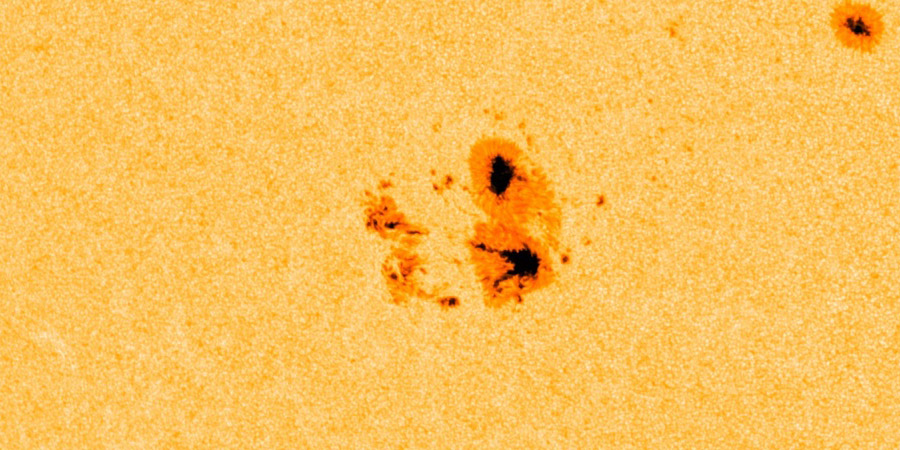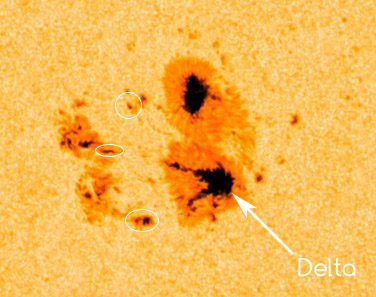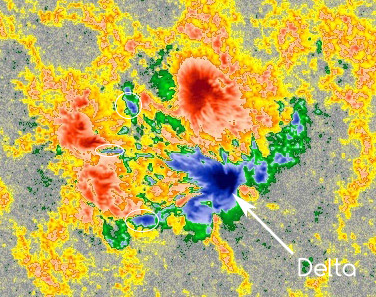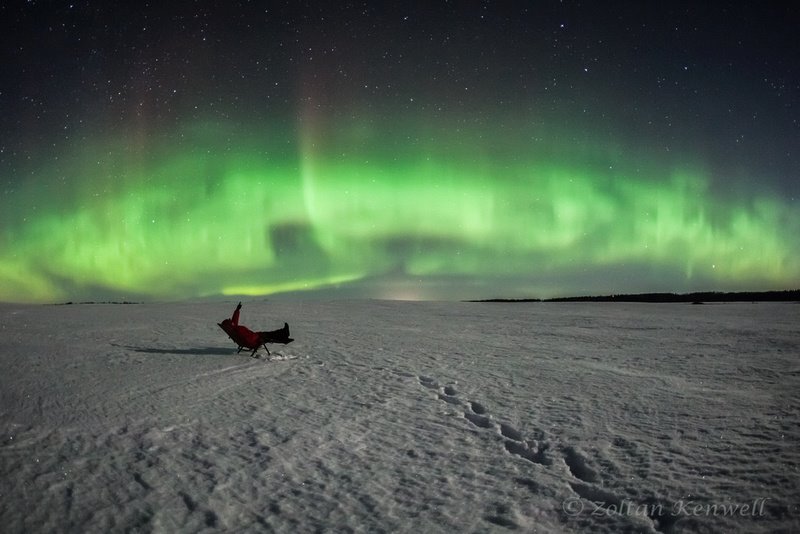Expanding sunspot region 2242
Monday, 15 December 2014 23:33 UTC

Solar activity was low today with only a couple of C-class solar flares to report. The strongest of these solar flares was an C7.0 solar flare at 01:40 UTC from sunspot region 2242. Sunspot region 2242 continue to expand today and is now the most threatening sunspot region on the earth-facing solar disk. What can we expect from it in the days ahead?
Sunspot region 2242
Sunspot region 2242 (Beta-Gamma-Delta) continued to expand both in size and magnetic complexity during the past 24 hours. If we compare this sunspot region with the images from yesterday (1 2) we can see that it developed quite a bit and now has even more magnetic mixing than yesterday. Let's go find the delta sunspots.
The very first and obvious delta sunspot that you can find is a large positive polarity delta sunspot south of the large negative polarity leader spot. While it has a penumbral connection, it is not a very compact grouping which is a key ingredient for real fireworks. Nonetheless this group's size and overall complexity could give us an interesting solar event in the days ahead.
Other sunspots of interest are marked with a circle. These are potential delta spots or spots with such a loose penumbral connection that it is hard to call them delta sunspots right now. It however does show that this is a group with a complex layout that is constantly changing. It should be monitored for further development.


M-class solar flares (R1-R2) are becoming more likely if this sunspot region continues to develop and gain in magnetic complexity. Sunspot region 2242 is now facing earth so any eruptions in the next 4 to 5 days could very well have an earth-directed component. Keep an eye on this sunspot region!
M-class flare probability for the coming 24 hours: 40% chance
X-class flare probability for the coming 24 hours: 5% chance
All the other sunspot region on the earth-facing solar disk have simple magnetic layouts and are unlikely to produce strong solar flares. Any activity will likely be centered around sunspot region 2242.
Auroral activity
Auroral activity remains elevated as we continue to see the influences of coronal hole high speed stream effects. Aurorae are still filling the skies at high latitude locations and will likely continue to do so in at least the next 24 to 48 hours. Photographer Zoltan Kenwell (website) from Canada decided to take things easy and watch both the Aurora Borealis and the Geminids meteor shower from his comfortable recliner. Great shot!

Images: NASA SDO, Zoltan Kenwell (website)
Thank you for reading this article! Did you have any trouble with the technical terms used in this article? Our help section is the place to be where you can find in-depth articles, a FAQ and a list with common abbreviations. Still puzzled? Just post on our forum where we will help you the best we can!
Latest news
Latest forum messages
Support SpaceWeatherLive.com!
A lot of people come to SpaceWeatherLive to follow the Sun's activity or if there is aurora to be seen, but with more traffic comes higher server costs. Consider a donation if you enjoy SpaceWeatherLive so we can keep the website online!

Space weather facts
| Last X-flare | 2024/03/28 | X1.1 |
| Last M-flare | 2024/04/25 | M1.0 |
| Last geomagnetic storm | 2024/04/19 | Kp7 (G3) |
| Spotless days | |
|---|---|
| Last spotless day | 2022/06/08 |
| Monthly mean Sunspot Number | |
|---|---|
| March 2024 | 104.9 -19.8 |
| Last 30 days | 133.9 +26.6 |


